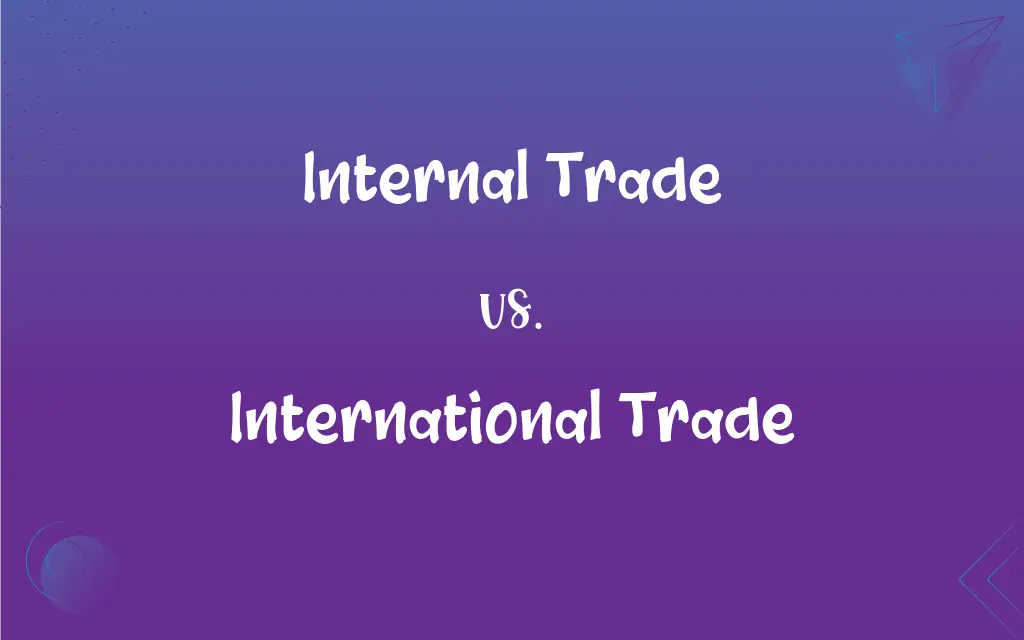Internal Trade vs. International Trade: What's the Difference?
Edited by Aimie Carlson || By Janet White || Published on March 30, 2024
Internal trade refers to the exchange of goods and services within a country, while international trade involves trading across national borders.

Key Differences
Internal trade, or domestic trade, occurs within the geographical boundaries of a country, involving the buying and selling of goods and services among local entities. International trade extends beyond national borders, encompassing the exchange of goods and services between countries. Both types of trade are vital for economic growth, but they operate under different regulatory frameworks.
In internal trade, transactions are governed by the country’s own laws and regulations, with no customs or tariffs involved. In contrast, international trade is subject to international laws, trade agreements, and tariffs. These contrasting regulatory environments affect the complexity and cost of trade in each context.
Internal trade does not face the same linguistic and cultural barriers as international trade. When trading internationally, businesses often need to navigate differences in language, culture, and business practices, which can pose additional challenges.
The scale of transactions can also differ, with international trade often involving larger volumes and values due to the broader market reach. Internal trade, while potentially substantial, usually caters to a more limited domestic market.
Internal trade helps maintain the economic stability of a country by facilitating the distribution of goods and services nationally. International trade, on the other hand, not only supports economic growth but also promotes global connections and interdependence among countries.
ADVERTISEMENT
Comparison Chart
Geographical Scope
Within a country’s borders
Across national borders
Regulatory Environment
Governed by domestic laws, no customs or tariffs
Subject to international laws, customs, and tariffs
Cultural and Linguistic Barriers
Minimal to none
Often significant, requiring navigation of differences
Scale of Transactions
Usually caters to domestic market
Larger scale, broader market reach
Economic Impact
Facilitates national distribution and stability
Promotes global trade, economic growth, and connections
ADVERTISEMENT
Internal Trade and International Trade Definitions
Internal Trade
Trade of goods and services within a country.
The wholesale market in Los Angeles is a hub of internal trade for California.
International Trade
Encounters cultural and linguistic barriers.
Multinational companies often hire local experts to navigate international trade challenges.
Internal Trade
Involves buying and selling activities among local entities.
Small businesses contribute significantly to internal trade in the United States.
International Trade
Involves multiple countries with varied trade agreements.
The European Union has streamlined international trade among its member countries.
Internal Trade
Restricted to a country's geographical boundaries.
The robust internal trade in Germany helps sustain its economy during global downturns.
International Trade
Subject to international tariffs, laws, and regulations.
NAFTA greatly influenced the dynamics of international trade in North America.
Internal Trade
Governed by domestic trade policies and regulations.
Internal trade in Japan is facilitated by its efficient transportation network.
International Trade
Exchange of goods and services across national borders.
China’s international trade has grown significantly, making it a global economic powerhouse.
Internal Trade
Free from international customs duties and tariffs.
The internal trade of agricultural products is vital for India's food security.
International Trade
Promotes global economic interdependence.
International trade agreements have been crucial in building strong economic ties between the US and Europe.
FAQs
Can internal trade affect a country’s GDP?
Yes, robust internal trade can significantly contribute to GDP.
What is internal trade?
The buying and selling of goods and services within a single country.
What are common barriers in international trade?
Language, cultural differences, and varying regulations.
Are tariffs relevant in internal trade?
No, tariffs are generally applicable only in international trade.
What defines international trade?
The exchange of goods and services between different countries.
How does international trade benefit economies?
It promotes economic growth, diversity, and global connections.
What legal aspects differ between internal and international trade?
Internal trade is governed by national laws, whereas international trade is also subject to international agreements and laws.
How do customs affect internal and international trade?
Internal trade doesn’t involve customs; international trade often does.
What role do exchange rates play in trade?
In international trade, exchange rates can significantly impact costs and profits.
How do trade agreements affect international trade?
They can facilitate or restrict trade flows between countries.
How does technology impact these types of trade?
It streamlines both, but is especially crucial in managing complexities of international trade.
How does political stability affect trade?
It significantly influences both, but especially international trade relations.
Does international trade require more logistics planning?
Generally yes, due to longer distances and more complex shipping requirements.
What skills are important for success in international trade?
Understanding of global markets, languages, and cultural nuances.
What is the role of government in internal and international trade?
Governments regulate both, but they play a more complex role in shaping international trade through policies and negotiations.
How do economic policies impact these types of trade?
Policies can encourage or restrict both, but particularly influence international trade dynamics.
Can internal trade be impacted by global events?
Yes, although it is usually less directly affected compared to international trade.
Does internal trade involve export and import?
No, exporting and importing are terms specific to international trade.
Can a business participate in both types of trade?
Yes, many businesses engage in both internal and international trade.
How does consumer preference affect these trades?
Consumer preferences drive demand in both, but with different scopes and scales.
About Author
Written by
Janet WhiteJanet White has been an esteemed writer and blogger for Difference Wiki. Holding a Master's degree in Science and Medical Journalism from the prestigious Boston University, she has consistently demonstrated her expertise and passion for her field. When she's not immersed in her work, Janet relishes her time exercising, delving into a good book, and cherishing moments with friends and family.
Edited by
Aimie CarlsonAimie Carlson, holding a master's degree in English literature, is a fervent English language enthusiast. She lends her writing talents to Difference Wiki, a prominent website that specializes in comparisons, offering readers insightful analyses that both captivate and inform.































































